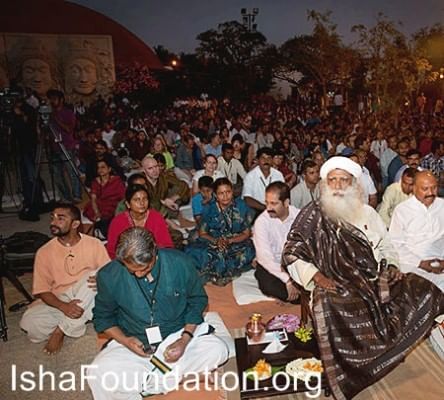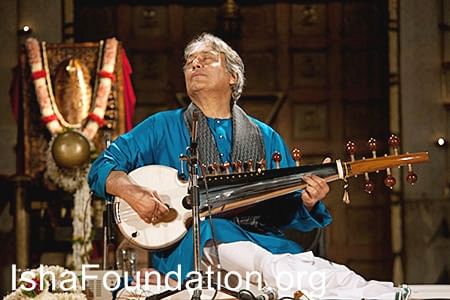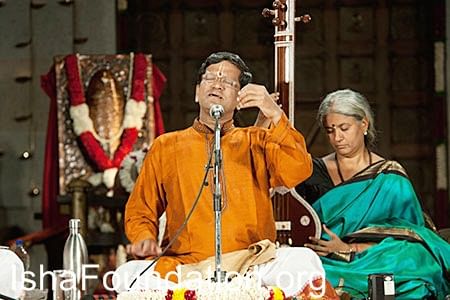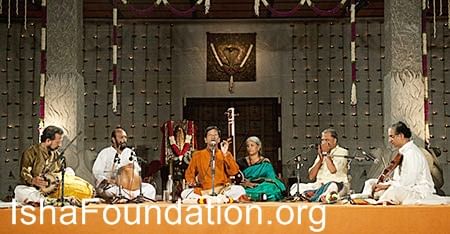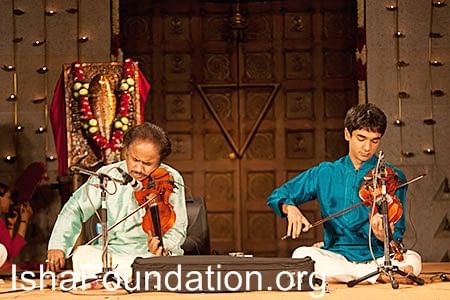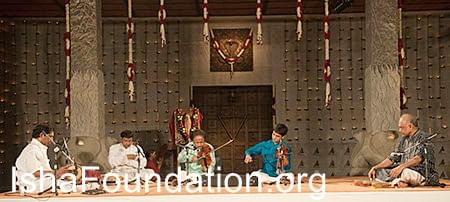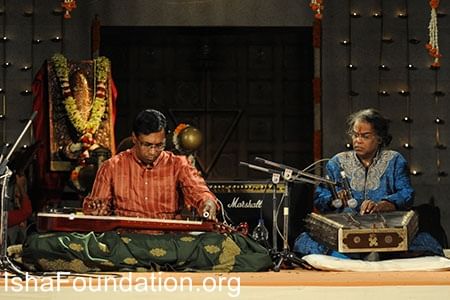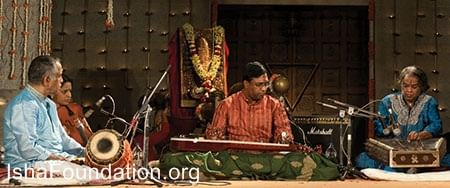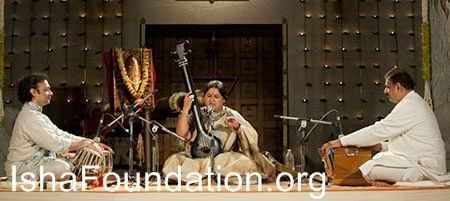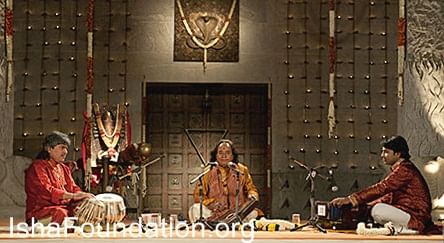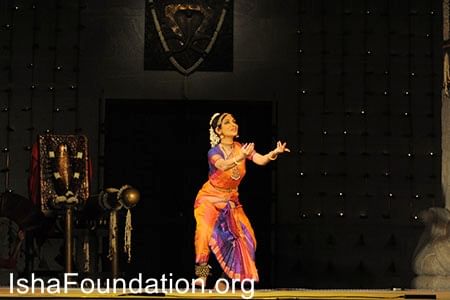Yaksha 2012 Live Blog
This spectacular and colorful cultural event will be celebrated between 4th and 6th March, 2015, and will feature 3 consecutive nights of musical concerts and dance by some of the greatest artistes in India. Join us live from 6:50 - 8:30pm for the web streaming of the event.
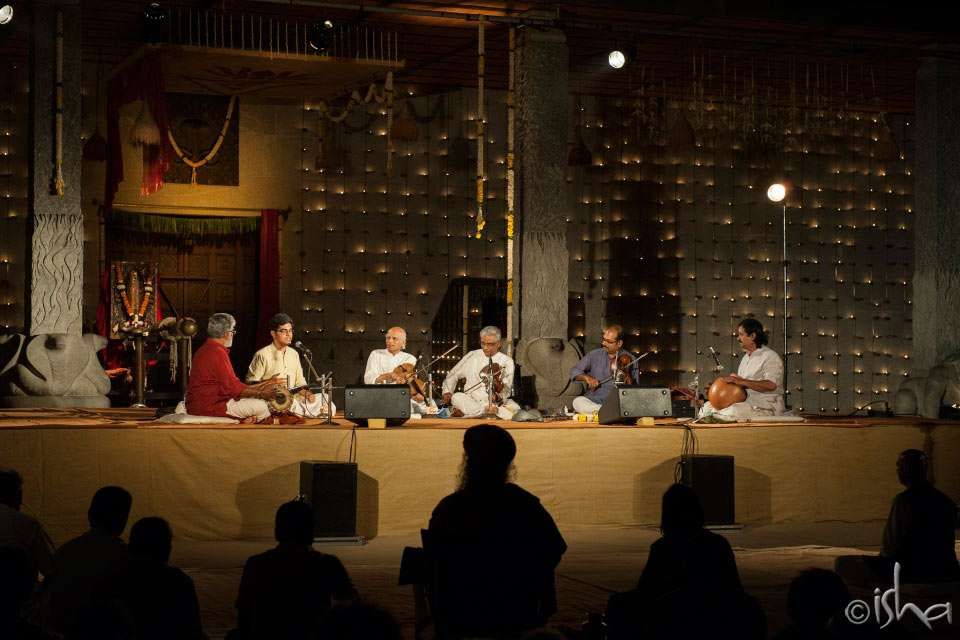
19 Feb - 8.49pm
This was followed by a folksy melody from the Kafi thaat in Raga Zila Kafi set to Deepchandi taal. This is a raga that is much used to bring out the flavor of Holi, the festival of colours.
The next piece was the hauntingly lovely Charukeshi – a borrowing from South Indian classical music. Then came a tarana in Raga Bahar, which was a salute to Hazrat Amir Khusrau, followed by a nod to the great Rabindranath Tagore with the ever popular Ekla chalo re. The Ustad finished the concert in the traditional manner with the sublime Bhairavi.
19 Feb - 7.50pm
Amjad Ali Khan’s opening piece was a mellow composition that weaved together a few beautiful evening ragas… Shree, Marwa, Purya Dhanashree and Purvi and set to Deepchandi taal. The artiste said this was a tribute to Sadhguru for his work and his commitment to humanity.
The next item was peppered with bhajans much cherished by Mahatma Gandhi: Vaishnava Jana in Raga Khamaj segueing into Raghupati Raghava Raja Ram in Mishra Gara. Both were interestingly interpreted by the maestro.
“In our family, we feel connected to every soul, every religion of the world. We are grateful to god for creating music,” he said.
19 Feb - 7.08pm
Padma Vibhushan Ustad Amjad Ali Khan is a Hindustani classical musician who plays the sarod. He was born into the illustrious Bangash lineage rooted in the Senia Bangash School of music. It was this family that brought the rabab to India in the 18th century, and it was Ghulam Ali Khan Bangash, the court musician of Gwalior, who gradually transformed the rabab into the sarod as we know it today. Amjad Ali Khan’s sons Amaan and Ayaan are the seventh generation of players in this musical family. “Sarod is a precious gift of god to our family,” the Ustad said, “Sarod is a Persian name which meant music – it is actually ‘sarood’ in Farsi.” Today, Amjad Ali Khan is accompanied by Tanmay Bose on the tabla and Fatehsingh Gangani on the pakhawaj.
In the audience today are illustrious guests: G Mallikarjuna Rao of the GMR group, Dr Prathap C Reddy, Chairman of the Apollo Group of Hospitals, Raghu Iyer, CEO of Rajasthan Royals cricket team, and Dilip Cherian of Perfect Relations.
18 Feb - 8.30pm
The atmosphere for Yaksha is always beautiful with the Devi temple lit by scores of lamps. This evening there is an added element – a long series of sky lanterns have been released and they float above the already gorgeous courtyard in a golden stream, gladdening the hearts of the audience. Neyveli Santhana Gopalan continued with Chandrachuda Shiva Shankara, a Kannada composition by Purandara Dasa.
The artiste then ended his recital with a Dhrupad piece in Raga Purvi on the joys of nirguna worship.
18 Feb - 7.52pm
Neyveli Santhana Gopalan began with an invocation to Lord Ganesha: Vatapi Ganapatim in Raga Hamsadhwani. Then he sang a composition Naada Tanumanisham in Raga Chittaranjani. Here Saint Thyagaraja is calling Shiva 'Nadatanu', the embodiment of the primodial naada.
Then keeping with the dominant theme of Shiva for the evening, he sang Ramanatham Bhajeham in Raga Pantuvarali, a kriti about Shiva in Rameshwaram by Muthuswamy Dikshitar. The traditional scale of the raga is at least 2000 years, he said.
18 Feb - 7.02pm
Neyveli Santhana Gopalan is a noted, respected Carnatic vocalist. He is known for his traditional and purist styles of rendering ragas, musical compositions and swaras. His style is distinguished by his adherence to strict raga interpretation, and lack of ostentation in ragam-tanam-pallavis.
The artiste has been to Isha before to conduct workshops and interact with the Samskruti children and said he was very happy to be back again. His purist attitude to music comes, he told the blog team, from his being a vainika, a veena player. The Saraswati veena is held to be the basis of Carnatic classical music and there is a school of musical thought that holds its superiority very high: “By the end of the concert, I should feel that I am the veena.”
He is accompanied today by VV Ravi on the violin, KV Prasad on the mridangam, SV Ramani on the ghatam and A Krishnan on the morsing.
17 Feb - 8.32pm
Subscribe
The next composition, in praise of Shiva, was a composition by the artiste’s father Prof. Lakshminarayana. Called Shiva, Shiva, Shiva, it is set to Raga Karaharapriya in Roopaka talam. The members of the audience were treated once again to Dr Subramaniam’s masterly command of the violin but equally impressed with the 19-year-old Ambi Subramaniam, who has clearly inherited the talent that abounds in the family. He gave his first performance at the age of seven and also plays the Western violin.
Dr Subramaniam and party then finished the recital with a couple of very melodious short solos.
17 Feb - 7.25pm
Padmabhushan Dr L Subramaniam is an acclaimed violinist, composer and conductor. He performs in the Carnatic style but is also known for his forays into Western classical music. He is extremely versatile – apart from these two genres, he has composed for and conducted major orchestras, scored for films, collaborated with a wide range of great musicians from different genres of music including jazz, occidental, jugalbandis with Hindustani musicians, world music and global fusion. He is particularly renowned for his virtuoso playing techniques. He is joined today by his son Ambi Subramaniam. He is accompanied by DSR Murthy on the mridangam, by G Sathysai on the morsing and by Satish Pathkota on the kanjira.
He began his performance with a kriti in Raga Hamsadhwani in praise of Lord Ganesha.
16 Feb - 8.20pm
Before they begin, Ravikiran explains a bit about the instruments they are playing. The old Indian name for Santoor is the shata tantri veena – for it has almost 100 strings. The Chitravina is a slide instrument with 20 to 21 strings – the strings are plucked with the right hand and the slide is moved by the left. The sounds of the two instruments blend particularly well.
The artiste-duo begins with the romantic evening raga Keeravani/Kirwani. After a lingering aalap, Ravikiran who is also a vocalist sang the opening notes of the composition Paratpara, Maheshwara, Dayakara set to Adi talam. The banter between all artists on the stage was fluid and the musical conversation most enjoyable.
They conclude with a brief portrayal of Hamsadhwani set to Roopak talam. Tarun Bhattacharya had said earlier, “They are both romantic ragas but Kirwani has more pathos and Hamsadhwani is lighter in mood.” Both artistes said they were delighted to perform in such beautiful surroundings.
16 Feb - 7.34pm
This evening’s performance is a jugalbandi – a collaboration between the Carnatic musician Chitravina N Ravikiran and Tarun Bhattacharya on the santoor in the Hindustani style.
Ravikiran plays the rare Chitravina or the gottuvadyam and was a child prodigy, who impressed an array of musicians at the age of two with his astounding knowledge of ragas. Tarun Bhattacharya belongs to the Maihar gharana and the two artistes have enjoyed collaborating with each other before. Tarun Bhattacharya is accompanied on the tabla by Abhijit Banerjee, and Ravi Kiran accompanied by the mridangam wizard Trichy Shankaran. They are supported by Akkarai Subhalakshmi on the violin.
15 Feb - 8.42pm
In a series of short presentations, Shubha Mudgal drew liberally from the Bhakti and Sufi saints – Kabir, Raidas and Amir Khusrau. From Kabir, she sang Mai ghulam mohi bech gusai.
Beche Ram toh raakhe kaun
Raakhe Ram toh beche kaun
If Ram sells me away, who’ll keep me
And if Ram keeps me, who can sell me?
Next, from Raidas came the evocative Ab kaise choote Ram naam rat laagi followed by a languorous composition in Raga Bageshri called Satguru sahib jab mehr kari. She followed that up with a song from Amir Khusrau, Daiyya ri, mohe bhejo yaari sung by Khusrau in praise of his master, Nizamuddin Aulia. It was an absolute treat to hear all these poets in Shubha Mudgal’s voice.
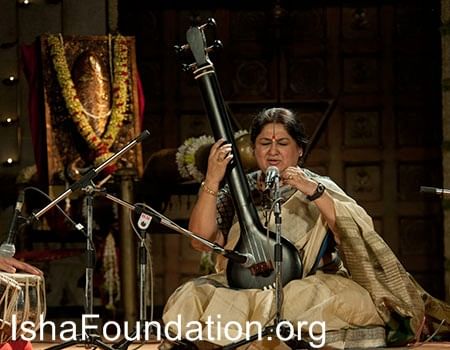
15 Feb - 7.14pm
Padmashri Shubha Mudgal is a well-known singer of Hindustani classical music. She sings khayal, thumri, dadra as well as pop. She is accompanied today by Aneesh Pradhan on the tabla and Sudhir Nayak on the harmonium.
She begins the recital with an evening raga, the mellifluous Yaman. The first composition is in praise of Shiva: Devan dev mahaan followed by Devi Dayani Daani Daata in praise of the Goddess. Both compositions were by Shubha Mudgal's guru, Pandit Ramashreya Jha. Earlier the artiste met the blog team. She said, “To sing in a space charged with this kind of energy is always special – it has been designed so carefully. I feel this is not really a performance… it comes from a tradition of making a small offering.”
14 Feb - 8.59pm
The artiste then presented an array of offering from the Benaras region: the forms of Thumri, Dadra, Chaiti and Hori. It was superb lecture-demonstration of the sub genres, for Panditji interspersed informative commentary and snippets from various sources to illustrate the point he was making. So we saw the feminine Thumri and the Chaiti contrasted with the Dadra and the masculine Chait.
For the Hori, the artiste offered two – one depicting the shringara rasa with Radhika’s holi, which is full of mischief and merriment; and the other, a Shiva bhajan, where the song talks of Shiva’s holi in the smashana, the funeral grounds where ash replaces gulaal or the holi colors.
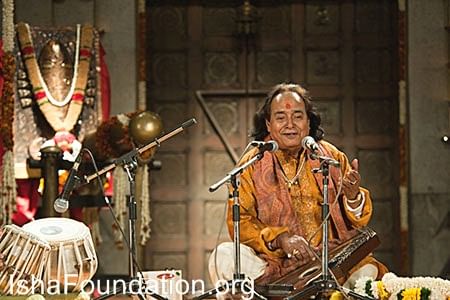
14 Feb - 8.02pm
After an invocation to Durga, Pt Chunnulal Mishra began the evening with Raga Shyam Kalyan – a raga that is dedicated to Shyam, i.e. Krishna, and Kalyan, which is Shiva: He Kartaar tum ho udaar. In the same raga, he segued with Shankar, Shiva, Dhani, a composition by Ramdas, containing 12 names of Shiva.
He said: “The Mother’s durbar, mention of Shiva and the company of saints – the music has no choice but to flow! I have played in so many places but none so beautiful as this.” The next was a charming juxtaposition of the Carnatic and Hindustani styles with Raga Hamsadhwani. Panditji is particularly fond of the southern school of classical music and he sang the very popular Vatapi Ganapatim before singing a northern variant with Jai Durge, Jagdambe, Bhavani.
14 Feb - 6.49pm
Padmabhushan Pandit Channulal Mishra is a noted exponent of the Kirana gharana school of Hindustani classical music and is known for his expertise with the khayal and the Purab ang thumri. He also sings a diverse number of forms including dadra, chaiti, kajri, hori and bhajans. Additionally he draws his material from a wide range of sources and languages, which makes his performances a wonderful blend of music and lyric.
Speaking to the blog team earlier, he said he looked forward to this evening’s performance. “When classical music is performed, it is not on a stage, which is for drama; not on a platform, which is for speeches. When classical music is performed it is always as if it is offered in a temple. Today we will literally be playing at the Devi temple, which automatically uplifts both performer and audience.”
13 Feb - 8.55pm
The fourth and final piece was pure dance, and a collaboration of a fairly interesting nature. Alarmel Valli danced to a poem by Arundhathi Subramaniam called Vigil. In the dance itself, two voices – the poet’s and the dancer’s – recite the poem, which is a somewhat ironic take on a woman’s wait for her lover. The dancer said that this was their special offering to Sadhguru.
Talking of what dance means to her, Alarmel Valli told the blog team, “Dance, to me, is a prayer with my entire being.” Speaking very much like an Isha although this is her first visit to the ashram, she adds, “Dance is a form of yoga. The sadhana, the bhakti, the commitment, the practice, the holding of the body, the mind, the spirit… all that goes to the making of the dancer – if you dance with Truth.”
13 Feb - 8.30pm
In her third piece, the artiste presented Nrityalahiri, a pure dance composition in Raga Rasikapriya. Marked by nadai or cross-rhythms this item weaves in a verse addressed to the land: Nada kundro, kaada kundro… The essence being that no matter what the landscape – whether hills or forests – it takes its goodness from the people inhabiting it.
13 Feb - 8.14pm
Next, in a tangent that is nevertheless very significant to the ongoing Mahabharat mega event, the danseuse portrayed vignettes from the life of Krishna. Calling it Krishna, the Intimate and the Infinite, she looks at his saulabhyam and paratvam, the ease of access he affords and the lofty ideal he represents. Culling from the Bhagvad Gita, Narayaniyam and Yadava Abhyudaya among others, she presents various glimpses of his life and glory.
13 Feb - 7.42pm
Yaksha 2012 kicks off with classical dance. Padmabhushan, Padmashri Alarmel Valli is a renowned Bharatnatyam dancer and choreographer. She is an exponent of the Pandanallur style and specialises in blending dance and music admirably. She has also learnt the Odissi form and performed it for several years before turning exclusively to Bharatnatyam. She is the founder of 'Dipashikha', a centre for fine arts in Chennai.
In the beautiful settings of Isha Yoga Center, Alarmel Valli began her performance with worship of the Mother Goddess. Taking off from a benediction in Shakuntalam that sees Shakti as Prakriti, she examined various aspects of her – the romantic aspect, the cataclysmic aspect and the womanly aspect.



